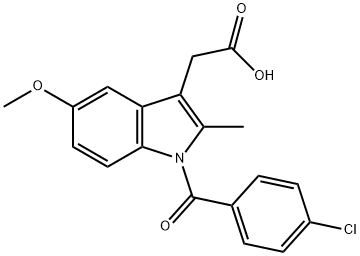Indomethacin , 99% , 53-86-1
Synonym(s):
1-( p-Chlorobenzoyl)-5-methoxy-2-methyl-1H-indole-3-acetic Acid;1-(p-Chlorobenzoyl)-5-methoxy-2-methyl-1H-indole-3-acetic Acid;1-(4-Chlorobenzoyl)-5-methoxy-2-methyl-3-indoleacetic acid;IDM;Indomethacin - CAS 53-86-1 - Calbiochem
CAS NO.:53-86-1
Empirical Formula: C19H16ClNO4
Molecular Weight: 357.79
MDL number: MFCD00057095
EINECS: 200-186-5
| Pack Size | Price | Stock | Quantity |
| 5G | RMB37.60 | In Stock |
|
| 25G | RMB80.00 | In Stock |
|
| 100G | RMB190.40 | In Stock |
|
| 500G | RMB628.00 | In Stock |
|
| others | Enquire |
PRODUCT Properties
| Melting point: | 158-162 °C |
| Boiling point: | 499.4±45.0 °C(Predicted) |
| Density | 1.2135 (rough estimate) |
| refractive index | 1.6800 (estimate) |
| storage temp. | Store at RT |
| solubility | ethanol: 50 mg/mL, clear, yellow-green |
| pka | 4.5(at 25℃) |
| form | White to off-white powder |
| color | White to Light yellow to Light orange |
| biological source | synthetic |
| Water Solubility | Soluble in acetone (40 mg/mL - clear, yellow solution), ethanol (20 mg/mL), ether, castor oil; Soluble in chloroform (50 mg/mL - clear, yellow, extremely viscous solution); decomposed by strong alkali but stable in neutral or slightly acidic media; insoluble in water. |
| Sensitive | Light Sensitive |
| Merck | 14,4968 |
| BRN | 497341 |
| BCS Class | 2 |
| Stability: | Stable. Incompatible with strong oxidizing agents. |
| InChIKey | CGIGDMFJXJATDK-UHFFFAOYSA-N |
| CAS DataBase Reference | 53-86-1(CAS DataBase Reference) |
| NIST Chemistry Reference | Indomethacin(53-86-1) |
| EPA Substance Registry System | Indomethacin (53-86-1) |
Description and Uses
Aqueous solutions of indomethacin are not stable because of the ease of hydrolysis of the p-chlorobenzoyl group. The original synthesis of indomethacin by Shen et al. involved the formation of 2-methyl-5-methoxyindole acetic acid and subsequent acylation after protection of the carboxyl group as the t-butyl ester. It was introduced in the United States in 1965. It is still one of the most potent NSAIDs in use. It also is a more potent antipyretic than either aspirin or acetaminophen, and it possesses approximately 10 times the analgetic potency of aspirin.
Indomethacin is used in rheumatoid arthritis, nonspecific infectious polyarthritis, gouty arthritis, osteoarthritis, ankylosing spondylitis, arthrosis, back pain, neuralgia, myalgia, and other diseases accompanied by inflammation.
Safety
| Symbol(GHS) |  GHS06 |
| Signal word | Danger |
| Hazard statements | H300 |
| Precautionary statements | P264-P301+P310 |
| Hazard Codes | T+,Xi,T |
| Risk Statements | 28-36/37/38-39/23/24/25-23/24/25 |
| Safety Statements | 28-36/37-45-36-26 |
| RIDADR | UN 2811 6.1/PG 1 |
| WGK Germany | 3 |
| RTECS | NL3500000 |
| F | 8-10 |
| TSCA | Yes |
| HazardClass | 6.1 |
| PackingGroup | I |
| HS Code | 29339900 |
| Hazardous Substances Data | 53-86-1(Hazardous Substances Data) |
| Toxicity | LD50 i.p. in rats: 13 mg/kg (Klaassen) |


